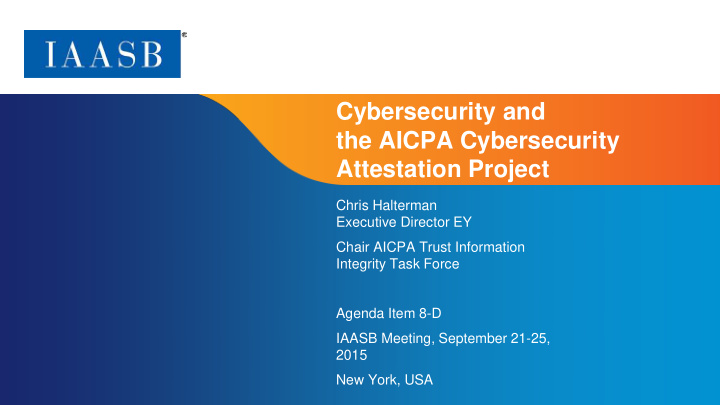



Cybersecurity and the AICPA Cybersecurity Attestation Project Chris Halterman Executive Director EY Chair AICPA Trust Information Integrity Task Force Agenda Item 8-D IAASB Meeting, September 21-25, 2015 New York, USA Page 1
Increasing awareness of cybersecurity exposure for business and other entities • Increased dependence on interconnected IT – Transaction processing – Increased value of information – Acceptance of proof of identify in electronic form • Cyber attacks have become more organized, profitable, and persistent • Cybersecurity has evolved into a critical business issue Page 2
Effective cybersecurity programs are a now a necessity for most entities • Goal of cybersecurity – Supports integrity of system processing and the information stored on systems, including but not limited to systems and information significant to financial reporting – Helps ensure systems and information are available when needed – Reduces the risk of compromise of confidential information, including • confidential personal information addressed by privacy laws and regulations • intellectual property and proprietary business data Page 3
Functions potentially involved in a cybersecurity program • Board/those charged with • CFO/finance governance • COO/operations • CEO • CIO • Senior management • IT security • Risk management and • Privacy office compliance • Others • General counsel Page 4
Information regarding cybersecurity at an entity is needed • Decision makers include – Those charged with governance – Investors – Customers – Business partners – Regulators • The information needed is mostly unique from what is needed for financial reporting purposes Page 5
Two distinct needs for cybersecurity information • As it relates to financial reporting of entities – Impact of business risks on financial audit – Impact of cybersecurity incident’s on an entity’s financial position and results • As it relates to the business operations and compliance of entities – Evaluation of users’ risks – Evaluation of the impact of entity’s operations on users’ operations Page 6
Internal control and cyber security at an entity Page 7
AICPA/CAQ response • Response of the profession in the US: – Center for Audit Quality has been leading a discussion on the effect of cybersecurity on financial audits • Separate and distinct from the AICPA cybersecurity attestation project • Communication to firms – AICPA has initiated a project to develop subject matter and attestation guidance for reporting on cybersecurity as it relates to the operations and compliance of an entity Page 8
CAQ communications to firms Auditor responsibilities – Identifying and assessing the risk of material misstatement • Understanding the nature of the entity and its environment • Understanding of the effect of IT on financial reporting and ICFR • Consideration of financial statement misstatement risk – Assess the impact of any breaches on financial reporting and ICFR Page 9
AICPA cybersecurity attestation project • Working group under the Assurance Services Executive Committee • Support from the CAQ • Member firm support • Outreach to users and industry as the project develops Page 10
AICPA cybersecurity attestation project • Goal – Identify the information needed by users for decision making – Develop cybersecurity information subject to engagement – Identify suitable criteria for evaluating the subject matter – Develop practitioner guidance Page 11
Timeline of AICPA IT Security Auditing 2002: Federal Information Security 2011 2000: BS 7799 Management Act SOC 2 Reporting on Controls adopted as ISO at a Service Organization 2010 17799 Relevant to Security, 1995: BS 7799 Availability, Processing 2003 SSAE 16 Reporting on Controls Predecessor of Integrity, Confidentiality and at a Service Organization ISO 27001/27002 Privacy 1999 Trust Services Principles & Criteria 1997 SysTrust Principles & criteria for systems reliability 1992 WebTrust Principles & criteria for electronic commerce 1982 SAS 70 Service Organizations 1974 1974 SAS 44 Special-Purpose Reports on Internal Accounting Control at Service Organizations SAS 3 The Effects of EDP on the Auditor’s Study and Evaluation of Internal Control Page 12
Key considerations for practitioners • Cybersecurity is a business issue with financial statement implications, affecting customers, business partners, investors and the public • Entities of all sizes and in all industries are affected • Practitioners need to be able to support stakeholder by: – Assessing the impact of a cybersecurity incident on financial statements – Providing independent assessments of cybersecurity risk management to concerned stakeholders – Providing an independent perspective regarding the entity’s cybersecurity risks and risk management program to those charged with governance and senior management Page 13
Near term developments in cybersecurity—some thoughts Page 14
Considerations going forward • Standards potentially affected by further cybersecurity developments – ISA 315 – Identifying and Assessing the Risks of Material Misstatement through understanding the Entity and its Environment – ISA 330 – The Auditor’s Responses to Assessed Risks – ISA 402 – Audit Considerations Relating to an Entity Using a Service Organization – ISA 620 – Using the Work of an Auditor’s Expert – ISAE 3402 – Assurance Reports on Controls at a Service Organization • Standards used to report on cybersecurity program – ISAE 3000 -- Assurance Engagements Other Than Audits or Reviews of Historical Financial Information Page 15
Questions? Page 16
www.iaasb.org
Recommend
More recommend